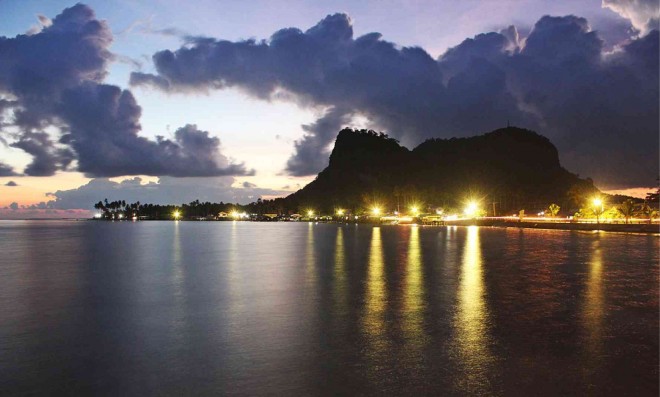Is Tawi-Tawi on your ‘bakit’ list?

ONE REASON TO GO Mt. Bongao is silhouetted against the sky at sunset in Tawi-Tawi province.
JOE A. BARRERA/CONTRIBUTOR
Tawi-Tawi is in the “bakit?!” list (list of whys) of many people. Why go to Tawi-Tawi? Why visit the remotest province in the south? Why go to a place perceived to be unsafe due to conflict, armed hostility and kidnapping? Why risk your life?
But the fact is Tawi-Tawi, founded in 1973, is a relatively peaceful place. Decades of untroubled conditions greatly contributed to its outstanding population growth, which tripled from 1995 to 2000. The period recorded the highest annual growth rate of 5.53 percent compared with other provinces in the Autonomous Region in Muslim Mindanao.
Ilocano, Boholano, Davaoeño, Tagalog, Bicolano and many other peoples from the archipelago have settled and intermarried with members of its original inhabitants—the Sama, Badjao, Jama Mapun and Tausug. Tawi-Tawi’s population in 1995 was 250,718 and in 2010, it expanded to 366,550—an increase of about 46 percent.
Of course, tourism authorities advise visitors to get clearance to eliminate security risks within the duration of stay. Armed soldiers are a common sight, which may be disquieting to visitors, as noted by Tourism Congress of the Philippines president Rosanna Tuason-Fores.
In her recent visit as guest of honor in the 2014 Agal-Agal Festival, Fores said the presence of armed soldiers portended a fragile peace and order situation.
But guns do not perturb the people here. Maybe what could be more unsettling for them is the absence of weapons for protection. Understand that the chain of islands that comprise Tawi-Tawi province was in the orbit of protracted fighting and conflict.
Even before the colonial period, self-defense tools were important to safeguard life, property and dominion. A local businesswoman who also frequents Manila has a nice way of describing the situation in their area: “In Manila, you cannot even walk on the street wearing gold earrings. More people are being kidnapped there compared to Tawi-Tawi.”
Come to think of it, Burma was dreaded by foreigners a decade ago. Now, it is a tourist destination and a haven for investors.
Again, why visit Tawi-Tawi?
The 107 islands and islets of the province are circled by white-sand beaches and crystalline waters. The islands are rich in biodiversity, replete with wildlife sanctuaries teeming with unique flora and fauna.
Some of the world’s endangered species thrive at Sibutu Natural Wildlife Sanctuary such as the “dandunay” (native peacock), “labuyo” (wild rooster) and wild boars of different colors—black, reddish brown, white and spotted black. Moreover, there are the world-famous sea turtles of Taganak, or Turtle Island.
Tawi-Tawi’s haunting seascapes and landscapes are beguiling to photographers and visual artists. The pervasive silhouette of Mt. Bongao evokes the dual images of an elephant and a reclining maiden.
The vibrant hues of sunsets and sunrises in these parts offer a breathtaking experience, if not serenity to the soul. The evening skies, adorned with a crescent or full moon, allow for peaceful evenings along beaches in the municipalities of Panglima Sugala, Bongao, South Ubian, Simunul, Sapa-Sapa and Mapun.
Tawi-Tawi is rich in history and cultural heritage. The Bolobok Cave in Sanga-Sanga is the site where Tridacna shell tools and stone tools were unearthed, used by early humans between 16,000 to 8,000 BC.
The province is the cradle of Islam in the Philippines. In 1380 AD, the Arab missionary Sheik Karimul Makhdum arrived in Simunul and spread the religion. To this day, one can go to Simunul to visit the oldest existing mosque in the Philippines known as Sheik Makhdum Mosque in Tubig Indangan.
Sacred burial sites, including the Tomb of Sheik Makhdum in Sibutu, are found in Tawi-Tawi.
Long before the advent of Islam in the country, Chinese traders bartered goods such as silk for much-coveted local mats woven with intricate designs. At present, the finest ones are made on Tandubas Island by women artisans led by master weaver Haja Amina Appi (†2013), a recipient of the national living treasure award.
Tawi-Tawi has many traditional arts and crafts such as basketry, embroidery and patchwork, pottery, wood and stone carving, metal smithing and metal craft, jewelry making and boat building. These artistic traditions are carefully documented in the book “Ukkil” (2006) by Ligaya Fernando-Amilbangsa, who was awarded in 2011 as the first most outstanding artist of Tawi-Tawi.
Amilbangsa’s findings trace the history of these arts and crafts to Hindu origin with Islamic influences, thereby proving the antiquity of these traditions. However, most of these arts and crafts are endangered, with the demise of skillful artisans.
The revitalization of traditional arts and crafts should be a big boost to trade and cultural tourism, as proven by the shining examples of tourist places such as Jogjakarta and Bali in Indonesia, and Chiang Mai in Thailand.
When it comes to food, Tawi-Tawi dishes are pleasant culinary surprises such as the “tiyulah itum” or black soup from roasted coconut, juicy “kagang” or crab, “syanglag” or roasted cassava rice and “agal-agal” salad. There is a wide variety of desserts such as “ja” (noodle-like rice cake) and “daral” (spring roll made with caramelized coconut).
So there. Consider Tawi-Tawi for your bucket, not “bakit” list.
(The author was a member of the board of judges in the Agal-Agal Festival held on Sept. 25 in Bongao, Tawi-Tawi. She is the managing director of AlunAlun Dance Circle and writer-director of “Ang Pagbabalik sa Tawi-Tawi” (2014), a full-length documentary film about the saga of Amilbangsa in documenting “pangalay” and other artistic expressions of the Sulu archipelago.)














